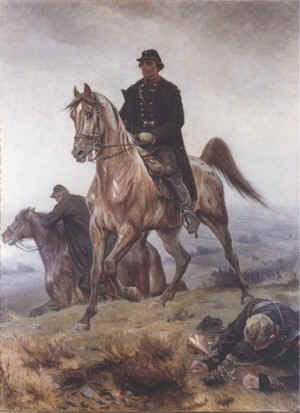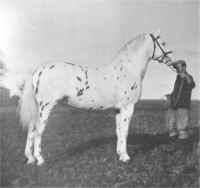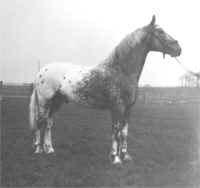|
Some
History about The
Knabstrup Horse
In
Denmark as early as in the Year 1671, there was a very popular Spanish
stud, called “The Tiger Horses”, which, in the year 1750, had reached
its summit what quality belongs. But the Royal breed came in the years to
come to a sad end, as the colour disappeared, probably because of the grey
gene.
In
1812 the colour returned to the breed in Denmark, but it was not after the
Royal horses, a new breed-line was started. Villars Lunn, owner of the
manor house “Knabstrupgaard” in the neighbourhood of Holbaek,
Nordsealand, bought from a butcher named Flaebe, a mare named “Flaebe”.
Probably the mare was of Spanish origin, but it looked very much like an
English hunter type. The butcher had bought the mare from a Spanish
officer, stationed in Denmark during the Napoleon wars.
The
unusual colour of the “Flaebe” mare was memorable. Beauty and quality
was together in the same horse. She was dark red (Zobelfuchs) with white
mane and tale, very much covered with small white snowflakes on the body,
and with brown spots on her blanket.
There
has been a lot of guessing about the origin of the “Flaebe” mare, but
a possible theory is, that she descends from Meklenbourg in Germany, where
the Spanish were stationed before they came to Denmark.
When
horses were bought to the stud farm, was it very much weighted, that the
animals, due to hard work, had shown great staying power and a good temper.
The “Flaebe” mare was in service at Knabstrup from the month of May
1812, as a light workhorse. Titular councillor of state V. Lunn, writes in
his memories, how the “Flaebe” mare in 1816 showed its value, as he
was run over by a carriage, and the doctor was needed immediately because
of a broken leg.A
farmhand took another team in the yard, rode to Holbaek, where the doctor
wasn’t home, from there to Buttrup vicarage, where he found doctor
Reinhardt, and then again, back to Knabstrup. It
was a fare of 30 km., and it was ridden in 105 minutes. The one horse was
damaged for life; the other was the “Flaebe” mare, and the very next
day she was back in the fields to work. At that time she was 15 years old.
All
of her progenies became fantastic colours, and she never became a one
coloured foal. The
“Flaebe” mare became the breed mother of the Knabstrup horse. She was
once covered by a yellow “Frederiksborg” stallion, and their foal was
a colt, named “The Flaebestallion”, and he bacame the foundation for
the new spotted breed. The “Flaebestallion” had a very unusual colour
as well. He was essentially lighter of colour, was often mentioned as
having more than 20 different colours, and he had a special metalshining
glow.
Another
colt of the “Flaebe” mare was “Mikkel”, born 1818. He was son of
his halfbrother the “Flaebestallion”, and was famous for his results
in horseracing. Even though he always drew a carriage the 6 Danish miles
(41 km.) to the racing ground in a forced speed, he was only defeated once,
as he was 16 years old, in a race in Copenhagen. “Mikkel” had been
ridden against a clod, and his chest was painful in the left side. It was
the only time another horse came in in front of him.
These
races were seen by many people, and gave the Knabstrup horse the
reputation of being a powerful and a great working capacity. “Mikkel”
is probably the most famous horse in the Knabstrup breed.
Knabstrup
horses were known for their high spirit and energetic action yet they were
not temperamental. They showed no signs of being malicious, and never had
vices like cribbing and wind swallowing. The fact that they were never put
into stalls, but mostly left outside, accounts for their ruggedness. The
Knabstrup horses got, and still gets, very old.
Danish
officers often used Knabstrup horses as mounts during the war 1848-1850. (Schleswig
war), but unfortunately, because of their eye-catching colour, they made
good targets for the enemy. In the Battle of Isted, 1850, two officers
rode loud coloured Knabstrup horses, and they both got shot. Colonel
Laessoee’s horse, a colourful mare “Nathalie”, escaped unharmed as
the colonel was shot, and in the years to come, she went on to raise
offspring. One foal was named “Laessoee” after the fallen Colonel:

"Colonel Laessoee in The Battle of Isted 1850"
painted by V.H.N. Irminger, 1912.
(The Museum of National History at Frederiksborg Castle)
The
other officer, general Schleppegral, had once used “Mikkel” as his
personal riding horse. During the Battle of Isted he rode one of the
Mikkel horses, and was also shot during the fighting. The stallion ran off
and disappeared. All efforts of the Danish Army to find the valuable horse
were in vain.
Unknown
to the army, several farmers in the hills of Skovby, caught the red
spotted stallion, and kept him hidden till the end of the war. Knowing his
value, they kept their lips sealed, but used him as a sire. Renamed
“Schnapegral-peerd”, the horses became separated from the actual
Knabstrup breed, and were greatly sought after by farmers in the area.
Much to their advantage, the stallions get had fine carriage, peculiar
colouring and lovely appearance.
As
late as 1910, a local was using a direct descendent of the earlier hidden
Stallion.
During
the 1870es, began at the Knabstrup stables an unavoidable downfall. At the
Lunn family the heard maintained at the time between the to Schleswig-wars,
between 40 and 50 spotted horses, all descendent of the “Flaebe” mare.
This inbreeding caused great difficulties in retaining colour and quality,
and the breed began to regress. 22 Knabstrup horses was killed during a
fire in 1891, and this fire, combined with the problems of inbreeding,
caused the number and importance of the breed to become smaller and
smaller.
Though
the horses of the Knabstrup stables met their downfall, they left behind a
great influence on horse breeding in the entire country. Breeders began
outcrossing to horses of Knabstrup parentage, and a new strain of spotted
horses was fostered. Still known by the same name, Knabstrup horses to
this day are enjoying popularity stronger than ever before.
The
tiger looking horses from Knabstrup was foundation for the breed in the
Holbaek-area, not to mention Bornholm and northern parts of Jutland. As a
circus horse it was popular as well.
Vendsyssel
(Northern Jutland) had from approximately 1930, a greater number of
tigered horses, with some variations in colour dispersion. These horses
had no connection to the breeds of Sealand.
1902
a tigered stallion from St. Petersburg was imported to Denmark. He got the
name “Mikkel”, and he was covering by A.F. Rasmussen, until he was 25
years of age. Some years he was the father of 60 – 80 foals, half of
them were more or less spotted. A Mikkel-son with the right colour, was
sold to a dairyowner, and has probably been the foundation for the new
generation of Knabstruphorses about 1930.
“Knabstrupgaard”
was not complete out of the picture after the fire. In the Year 1922 a
stallion from “Knabstrupgaard” was shown at the cattle show in Holbaek.
His name was “Mikkel”, and several farmers in the area used him. He
was rejected because of not acceptable colours, but he proved himself
valuable in the breed.
In
1947 ”Association for promotion of the Knabstrupper in county of Holbaek”
was founded in connection to stud farm “Egemosegaard”.
A
former farmer N.H. Nielsen and his son, barrister C.N. Ledager, with the
purpose to make a stud farm for Knabstrup horses, in attempt to, with
rational breeding, to continue development of this once so famous horse,
bought Egemosegaard in 1946. The stud farm bought two stallions 1946 –
1948, “Silverking II” & “Max Bodilsker”:
 |
 |
|
Silverking II |
Max Bodilsker |
In
1954 the stud farm was culminating with 15 horses in the stables. It had a
great reputation, and people from all over the country came to visit,
until the finish in 1959.
”Association
for promotion of the Knabstrupper in county of Holbaek” was still
fighting, but with the foundation of “Danish Sporthorse Breed
association” in 1962, which many Knabstrup breeders joined, everything
was close to total chaos.
Organisation:
In
1971 some Knabstrup breeders broke through, and founded the all country
covering “Knabstrup association”. (Knabstrupperforeningen for
Danmark).
Close
to anything being spotted or coloured, was registered. The stallions that
were selected had one quality only: the spots. A breeder, Frede Nielsen,
brought 3 appaloosa stallions to Denmark, to get new blood in the breed.
It
succeeded for 2 of them to characterise the Knabstrup breed. However, many
of the Sealand breeders preferred to crossbreed with “Danish Warmblood”.
The best results came after crossing with “Traken” horses and
“Holsten” horses. It was obvious that crossbreeding was the way
forward. The Knabstrup horse is a natural trotter, and as a type, the
“Traken” horse is closest to the original type.
It
is a common opinion, that the “Frederiksborg” horse is the breeding
strain of the “Knabstrup” horse, and that is not all wrong, but the
“Frederiksborg” horse has a very high pace, which is not attractive
for a riding horse.
It
is not of great importance if we use a one coloured horse once in a while,
as long as we remember to breed back again. If the colour is available, is
it the Knabstrup genes and character that will be dominating.
As
the Knabstrup breed became nation-wide, it seamed a natural thing to breed
ponies as well, because the colours appeals to children. And it was easy,
because many Knabstrup horses was about 150 cm., and breeding down was
quite as easy as breeding up. A few breeders has specialised in breeding
spotted ponies in miniature, like Shetland, so the ponies are here to stay.
The
colour:
The
spotted skin is difficult to control. It is no guarantee to crossbreed two
spotted horses; it can result in coloured as well as spotted foals, just
like a spotted and a plain horse very well can make a spotted foal. The
grey gene very often shows after breeding with a mouldy horse, and it can
be difficult to remove again.
The
Knabstrup horse is light coloured around the eye apple, meat coloured or
spotted around the natural openings, and the hoofs are with stripes or
light. |
